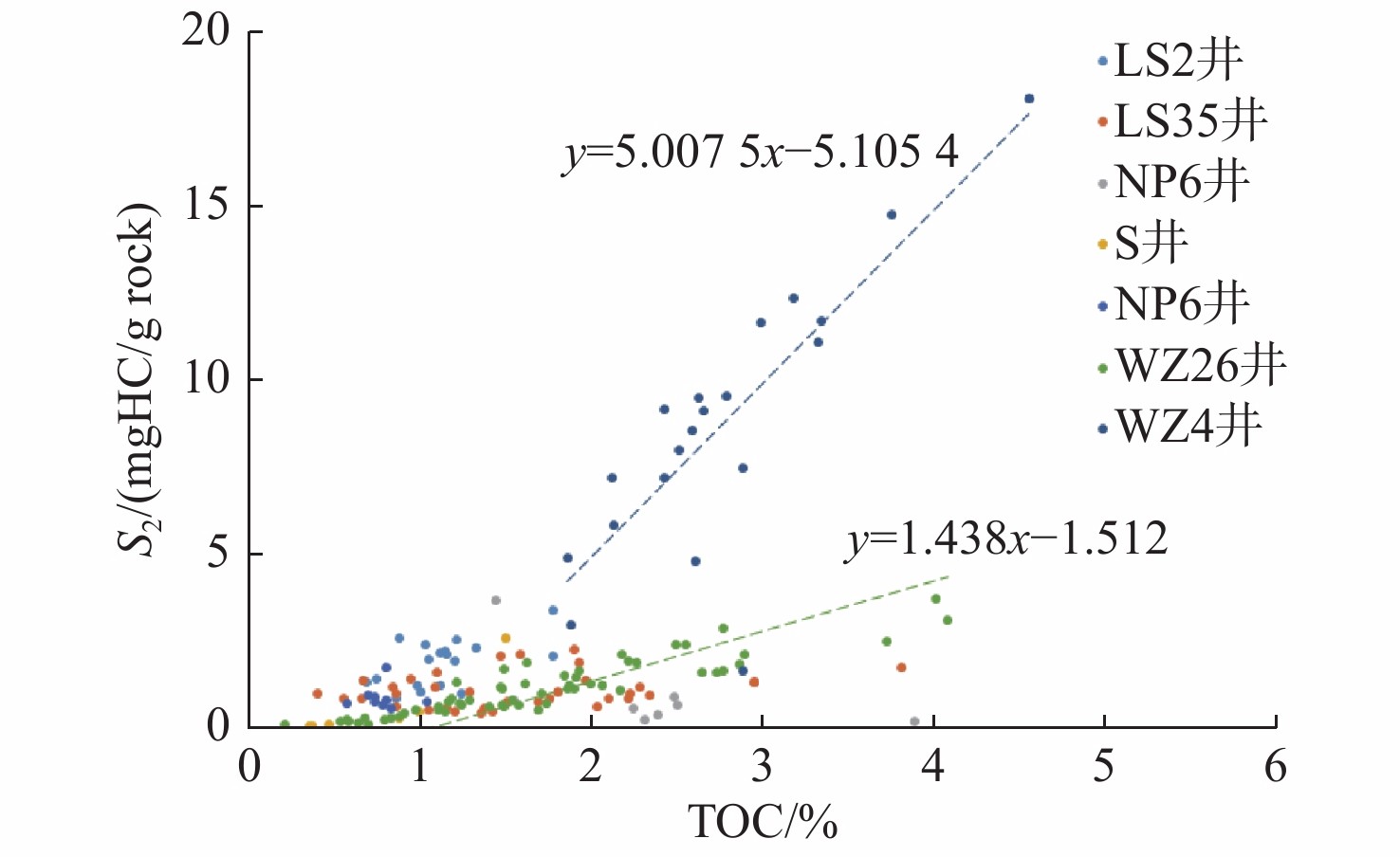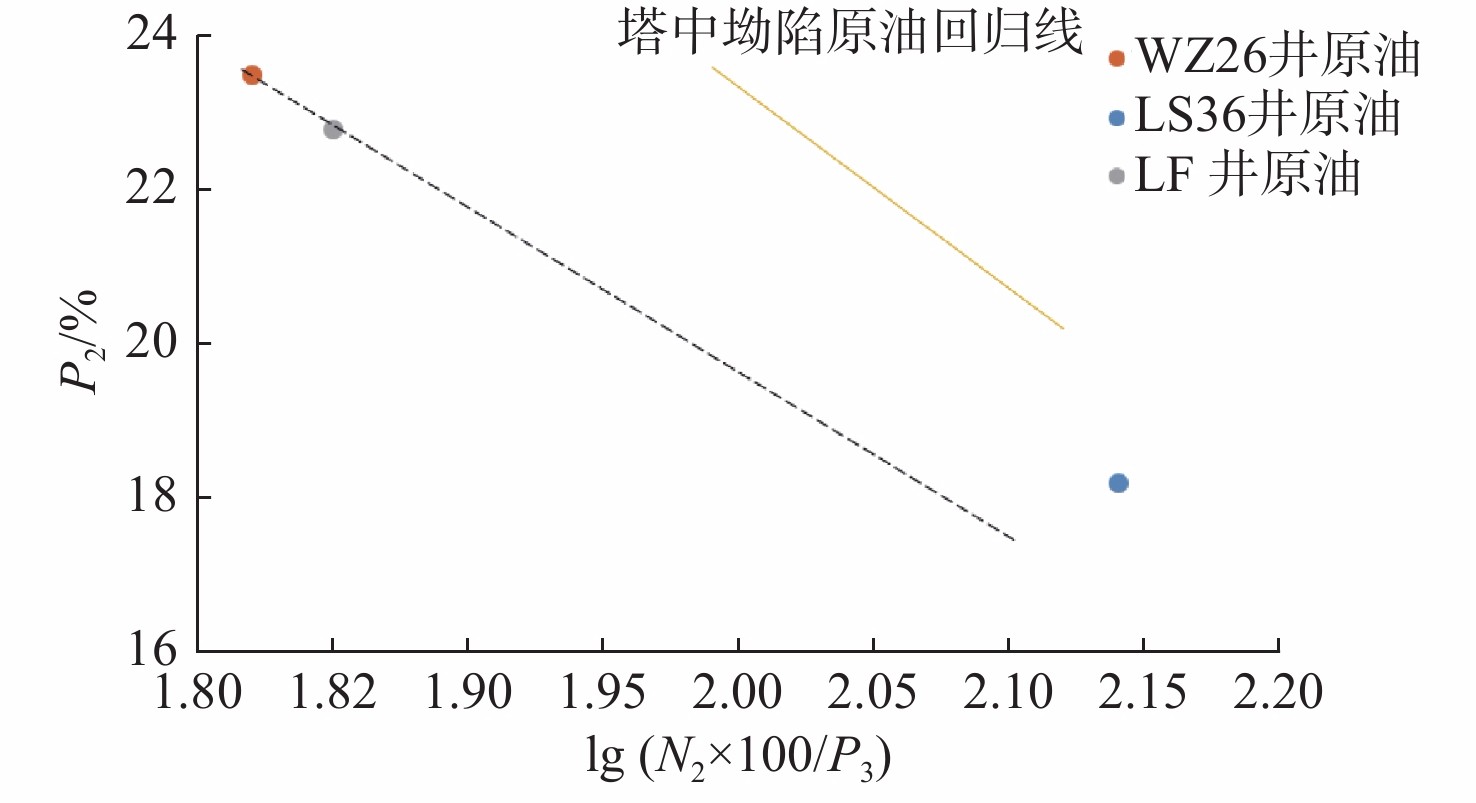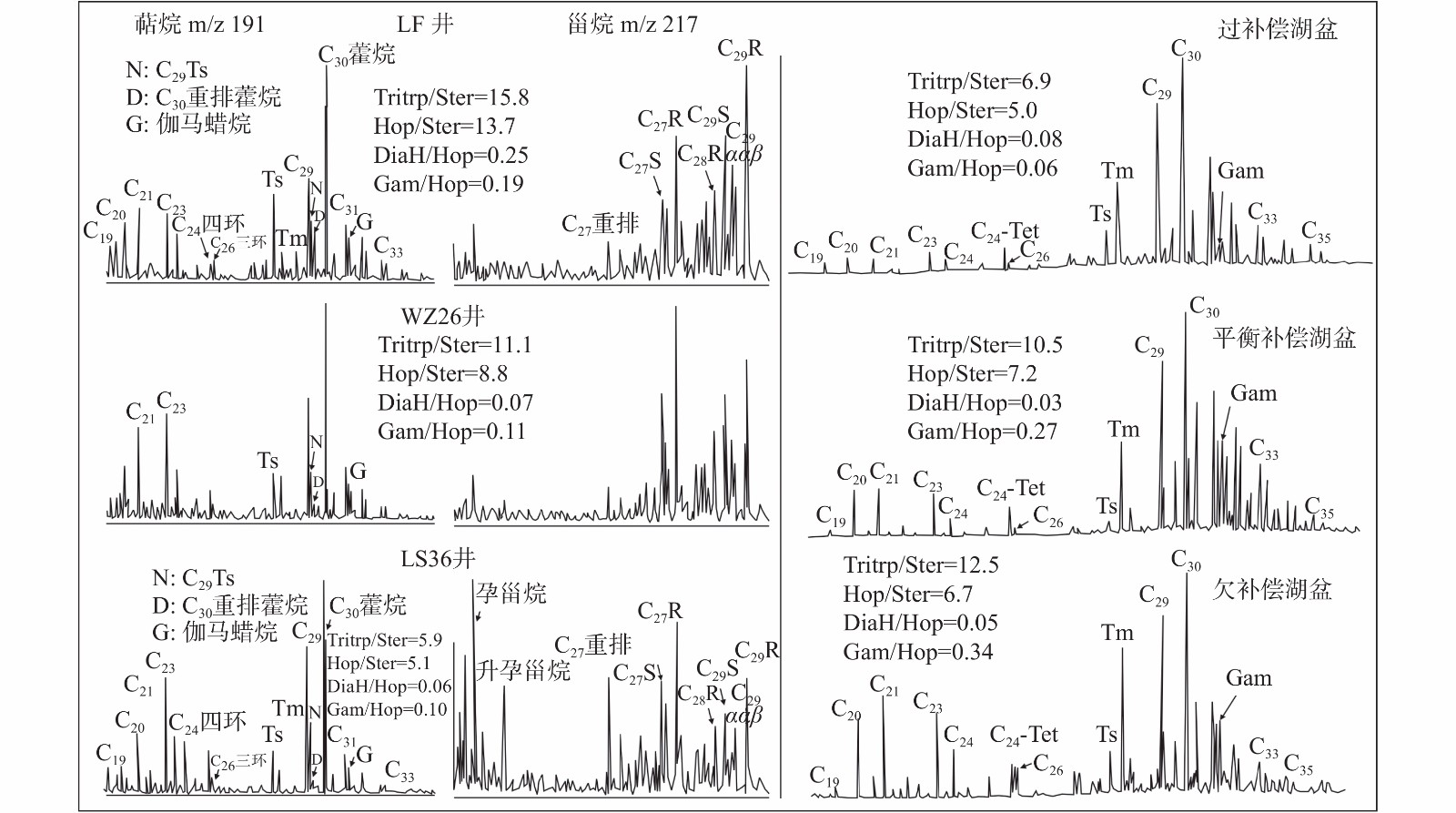AN ATYPICAL LACUSTRINE SOURCE ROCK AND ITS PETROLEUM CHARACTERISTICS IN THE LISHUI SAG OF THE EAST CHINA SEA
-
摘要:
东海陆架盆地丽水凹陷主力烃源岩为古新统月桂峰组湖相泥岩,已发现油气以天然气为主,含少量凝析油,与以原油为主的中国东部典型断陷湖盆存在差异。对月桂峰组湖相泥岩进行了综合评价,发现其存在不能生烃的死碳,烃源岩的热演化成熟度与烃源岩形成石油的转化参数之间存在差异。月桂峰组有机质主要来源于陆源有机质,湖相水生生物来源的比例变化较大。烃源岩地球化学特征与典型湖相烃源岩存在差异。总结了湖盆类型对烃源岩的控制因素以及不同湖盆类型烃源岩形成油气的主要特征,并与月桂峰组湖相泥岩及已发现油气特征进行了对比,表明月桂峰组沉积期发育过补偿和平衡补偿湖盆。月桂峰组泥岩为非典型湖相烃源岩。
Abstract:The lacustrine mudstone of the Yueguifeng Formation of Paleocene is the predominant source rock in the Lishui Sag of the East China Sea. Both natural gas and condensate have been found there. However, it is rather different in hydrocarbon sources with the typical lacustrine rift basins in Eastern China where oil dominates. Comprehensive source rock evaluation on the Yueguifeng shale suggests that there occurs dead carbon to certain proportion, which cannot generate petroleum. In addition, the thermal evolution maturities are not in coupling with the requirement of the conversion index from organic matters to hydrocarbons. The organic matters in Yueguifeng Formation shale are mostly terrestrial in origin, and the percentages of lacustrine aquatic organisms varies. There occur some differences in geochemical characteristics between the Yueguifeng source rocks and the typical lacustrine source rocks. The type of lake-basin have certain control over source rock evolution. Based on the comparison of geochemical characteristics of Yueguifeng source rocks and the petroleum generated in the sag with those of the typical lacustrine source rock and petroleum generated in different lake-type basins, it is found that over compensate and balanced compensate lake basin dominated the Yueguifeng period. And the shales in Yueguifeng Formation are atypical lacustrine source rocks.
-

-
表 1 丽水凹陷原油C4—C7轻烃组成
Table 1. C4-C7 light hydrocarbon composition of crude oil in Lishui Sag
正构烷烃/% 异构烷烃/% 环烷烃/% 芳烃/% 丽水凹陷 WZ26井 41.73 43.67 12.24 2.36 LS36井 25.35 30.82 40.86 2.98 LF井 33.12 31.36 33.21 2.31 锦州20-2(淡水湖相) 28.52 24.68 38.39 8.56 31.43 27.96 33.62 6.99 30.04 26.71 35.78 7.47 板桥(淡水湖相) 29.21 43.37 18.33 9.12 24.85 36.32 32.79 6.04 32.43 38.62 23.75 5.19 26.33 23.33 36.81 13.53 29.57 37.44 28.67 4.33 28.77 36.26 28.26 6.70 崖13-1(滨海沼泽相) 16.87 24.31 33.71 25.11 21.86 27.63 23.47 27.04 13.76 15.30 34.10 36.83 21.21 25.59 28.91 24.38 16.66 15.87 41.07 26.41 表 2 丽水凹陷原油族组成与碳同位素特征
Table 2. Group composition and carbon isotope of crude oil in Lishui Sag
井号 层位 颜色 饱和烃/% 芳烃/% 非烃/% 沥青质/% 全油碳同位素/‰ WZ26 月桂峰组 浅棕色 91.33 2.23 2.06 4.38 −28.7 LS36 明月峰组 黄色 65.79 29.02 4.28 0.90 −26.2 LS36 明月峰组 黄色 72.46 26.81 0.41 0.32 −26.8 LF 太古宙 棕黑色 90.42 4.26 3.11 2.21 −27.4 表 3 丽水凹陷天然气成分组成
Table 3. Composition of natural gas in Lishui Sag
井号 C1/% C2/% C3/% nC4/% nC5/% iC4/% iC5/% C6+/% CO2/% N2/% WZ13 4.76 0.51 0.17 0.03 0.01 0.03 0.01 94.47 WZ13 1.19 0.14 0.04 0.02 0.02 0 98.59 LS36 55.45 3.63 1.88 0.47 0.09 0.42 0.15 0.21 34.15 3.55 LS36 55.10 3.67 1.92 0.48 0.09 0.43 0.16 0.21 34.50 3.44 LS36 56.52 3.83 2.69 0.75 0.30 0.50 0.34 1.11 31.74 1.06 LF 59.48 11.95 10.02 4.49 1.69 4.04 2.17 6.16 表 4 丽水凹陷天然气中有机烃类成分组成与碳同位素组成
Table 4. Composition and carbon isotope of natural gas in Lishui Sag
井号 有机烃类成分 碳同位素 C1/% C2/% C3/% n C4/% nC5/% iC4/% iC5/% C6+/% C2+/% C1/C1+ C1/‰ C2/‰ C3/‰ nC4/‰ CO2/‰ WZ13 86.23 9.24 3.08 0.54 0.18 0.54 0.18 0 13.76 0.86 −44.20 −29.20 −32.60 −17.20 −4.00 WZ13 84.40 9.93 2.84 1.42 0 1.42 0 0 15.61 0.84 −46.60 −33.00 −33.20 −26.30 −4.20 LS36 89.00 5.83 3.02 0.75 0.14 0.67 0.24 0.34 10.99 0.89 −46.30 −29.55 −29.96 −26.86 −5.03 LS36 88.79 5.91 3.09 0.77 0.15 0.69 0.26 0.34 11.21 0.89 −46.13 −29.31 −27.07 −26.93 −4.67 LS36 85.58 5.80 4.07 1.14 0.45 0.76 0.51 1.68 14.41 0.86 −44.40 −28.90 −26.40 −27.00 −4.60 LF 63.38 12.73 10.68 4.78 1.80 4.31 2.31 0 36.61 0.63 −44.76 −27.24 −25.13 −25.52 −22.20 表 5 丽水凹陷已钻遇月桂峰组烃源岩地球化学特征
Table 5. Geochemical characteristics of source rocks in Yueguifeng Formation that encountered in Lishui Sag
湖相淡水 湖相咸水 WZ26井 月桂峰组 WZ13井 月桂峰组 LS35井 月桂峰组 WZ4井 月桂峰组 Ro/% 0.4~0.7 0.4~0.8 0.88~1.38 0.9~1.18 饱和烃/% 40~60 25~55 28.51~81.91 3.99~7.99 7.87~27.14 26.15~46.57 δ13C(PDB/‰) <−28 −23~−27 −27~−28.1 主峰碳 nC23 nC19 nC17,nC34 nC17,nC19,nC27 奇偶比 ≥1 ≥1 ≥1 ≥1 ≥1 ≥1 姥植比 >1.3 >1.1 >1.87 >1.78 >1.13 >1.5 C27/C29甾烷 1.5~4.0 1.5~2.5 0.66~1.51 0.51~0.91 1.02~2.51 0.34~0.47 重排甾烷指数 20~40 10~50 8.9~34 5~47 12.1~17 17~24 4-甲基甾烷指数 30~50 30~150 藿烷/甾烷 5~30 5~30 3.2~16.9 1.15~8.8 7.7~14.5 30~65 三环萜烷指数 30~100 100~200 103~287 28~720 57~234 5.1~8.5 C34/C35 藿烷 >1 >1 0.2~1.8 0.42~1.06 0.5~0.72 0.5~0.9 双降藿烷指数 0 3~15 奥利烷指数 0 0 0.06~6 0.08~0.99 0.03~0.6 0~0.02 Ts/Tm >1 <1 0.49~1.46 0.23~0.98 0.95~2.06 0.45~0.57 表 6 湖盆类型对烃源岩的控制因素
Table 6. Controlling factors of basin types on source rocks
湖盆类型 有机质生产力 破坏 稀释 烃源潜力 过补偿 营养物质供给多;淡水输入会降低营养物质浓度;随着湖盆体积增大生产力总体下降 水体底部氧气供给增加会破坏有机质;风的搅动形成均一的水体不利于有机质保存;冷的底流不利于有机质保存;扰动强度加大破坏有机质 丰富的碎屑会降低有机质丰度;大量的陆源碎屑 中等—差的油/气潜力;油气同生;明显的侧向变化;TOC:泥岩<1%~7%,煤<80%;有机质类型:藻类和陆源有机质混合(Ⅰ/Ⅱ);HI:50~600;厚度:0~100 m 平衡补偿 合适的营养物质供给;不定期的干燥增加营养物质浓度;大量的湖盆水体位于透光带有利于高生产力 封闭的盆地和不定期的干燥利于形成密度分层保护有机质;巨大的生产力消耗了水体底部的氧气有利于有机质保存 变化、相对较少的碎屑不会降低有机质丰度;少量的陆源碎屑有利于有机质保存;不定期的洪水和泄洪带来大量碎屑并会带走有机质 中等—很好的生油潜力;生油为主、有时少量气;侧向变化很少;TOC:1%~30%;有机质类型:主要藻类(Ⅰ),部分陆源有机质(Ⅱ);HI:500~700;厚度:相对较薄(1~10 m) 欠补偿 变化的营养物质供给;不定期的干燥增加营养物质浓度;过度的矿物质浓缩会破坏生物生存降低生产力;只有部分时间水体可以生产有机质 不定期的干燥使有机质氧化;不定期的淡化会带来氧气破坏有机质 半干旱气候提供最大的碎屑供给;较少的陆源有机质供给相对提高了藻类物质的丰度;由于大量矿物沉淀提高盐度有利于有机质保存 差—中等的生油潜力;生油为主;很小侧向变化;TOC:<0.5%~20%;有机质类型:藻类(Ⅰ);HI:50~600;厚度:相对较薄(1~10 m) 表 7 不同湖盆类型生成油气特征与丽水凹陷已发现油气特征对比
Table 7. Comparison of petroleum characteristics in Lishui Sag to those in different lake types basins
湖盆类型 已发现油气井 过补偿 平衡补偿 欠补偿 LS36 LS36 WZ26 LF 生烃潜力 变化 大 变化 有机质 陆源有机质,水生生物 主要水生生物,部分陆源有机质 沉积水体 淡水 氧化还原程度 弱氧化、氧化 油气类型 油、部分气和凝析油 含蜡量 >20 % 5%~25% <5%~10% <0.52% >18 >18 API 24°~57° 18°~45° 12°~37° 倾点 −5°~>20° 25°~59° −5°~>20° 含硫量 低 低 高,一般1%,可高达2% 0.28 含氮化合物 低 含氮化合物+芳烃5%~40% Pr /Ph 低 <1~2.0 < 1 5 5.5 2.86 3.61 藿烷/甾烷 高 0.5~15 低 2.47 2.1 1.72 1.55 甾烷 C29 C27 C27 C29 C29 C29 去甲基甾烷 丰富 4-甲基甾烷 有时含量高 伴有甲藻甾烷 伽马蜡烷 低 高 高 0.1 0.09 0.792 0.152 β胡萝卜烷 常常检测不到 中等含量 很高 -
[1] 葛和平,陈志勇,方来富,等. 丽水凹陷油气成藏期次探讨[J]. 中国海上油气(地质),2003,17(1):44-50.
[2] 葛和平,陈晓东,刁慧, 等. 东海盆地丽水凹陷原油地球化学特征及油源分析[J]. 中国海上油气,2012,24(24):8-12, 31.
[3] 葛和平,陈建平,陈晓东,等. 东海盆地丽水凹陷天然气类型及其成因探讨[J]. 中国科学(D 辑: 地球科学),2007,37(S2):104-110.
[4] CARROLL A R,BRASSELL S C,GRAHAM S A,et al. Upper Permian lacustrine oil shales, Southern Junggar Basin, Northwest China[J]. AAPG Bulletin,1992,76(12):1874-1902.
[5] CARROLL A R. Upper Permian lacustrine organic facies evolution, Southern Junggar Basin, NW China[J]. Organic Geochemistry,1998,28(11):649-667. doi: 10.1016/S0146-6380(98)00040-0
[6] CARROLL A R,BOHACS K M. Stratigraphic classification of ancient lakes: balancing tectonic and climatic controls[J]. Geology,1999,27(2):99-102. doi: 10.1130/0091-7613(1999)027<0099:SCOALB>2.3.CO;2
[7] CARROLL A R,BOHACS K M. Lake-type controls on petroleum source rock potential in nonmarine basins[J]. AAPG Bulletin,2001,85(6):1033-1053.
[8] 申雯龙,漆滨汶. 东海盆地丽水凹陷有效烃源岩判定及分布预测[J]. 地质科技通报,2020,39(3):77-88.
[9] 中国石油天然气总公司. SY/T 5735-1995 陆相烃源岩地球化学评价方法[S]. 北京: 中国石油天然气总公司, 1995.
[10] 中国海洋石油总公司. Q/HS 1017-2006 烃源岩地球化学定量评价规范[S]. 北京: 中国海洋石油总公司, 2006.
[11] PETERS K E, MOLDOWAN J M. The biomarker guide: interpreting molecular fossils in petroleum and ancient sediments[M]. New Jersey: Prentice Hall, 1993.
[12] HAZRA B, WOOD D A, MANI D, et al. Evaluation of shale source rocks and reservoirs[M]. Springer Nature Switzerland AG, 2019: 1-142.
[13] COMFORD C. Mandal-Ekofisk(!) Petroleum System in the Central Graben of the North Sea[C]//Magoon L B, DOW W G. The petroleum svstem: from source to trap. AAPG Memoir 60, 1994: 537-571.
[14] SCHNEIDER A C,MUTTERLOSE J,BLUMENBERG M,et al. Palynofacies, micropalaeontology, and source rock evaluation of nonmarine Jurassic-Cretaceous boundary deposits from northern Germany: implications for palaeoenvironment and hydrocarbon potential[J]. Marine and Petroleum Geology,2019,103:526-548. doi: 10.1016/j.marpetgeo.2019.02.016
[15] SONG J L,LITTKE R,WENIGER P,et al. Shale oil potential and thermal maturity of the Lower Toarcian Posidonia Shale in NW Europe[J]. International Journal of Coal Geology,2015,150/151:127-153. doi: 10.1016/j.coal.2015.08.011
[16] COLLISTER J W,WAVREK D A. δ13C compositions of saturate and aromatic fractions of lacustrine oils and bitumens: evidence for water column stratification[J]. Organic Geochemistry,1996,24(8/9):913-920.
[17] PETERS K E, WALTERS C C, MOLDOWA J M. The biomarker guide: biomarkers and isotopes in petroleum exploration and earth history[M]. (vol. 2).Cambridge: Cambridge University Press, 2005.
[18] PETERS K E,LILLIS P G,LORENSON T D,et al. Geochemically distinct oil families in the onshore and offshore Santa Maria basins, California[J]. AAPG Bulletin,2019,103(2):243-271. doi: 10.1306/07111818014
[19] HOSSEINIA H S,HORSFIELD B,WILKES H,et al. Comprehensive geochemical correlation between surface and subsurface hydrocarbon occurrences in the Batman-Mardin-Şırnak area (SE Turkey)[J]. Marine and Petroleum Geology,2018,93:95-112. doi: 10.1016/j.marpetgeo.2018.02.035
[20] GAO G,YANG S R,ZHANG W W,et al. Organic geochemistry of the lacustrine shales from the Cretaceous Taizhou Formation in the Gaoyou Sag, Northern Jiangsu Basin[J]. Marine and Petroleum Geology,2018,89(1):594-603.
[21] 卢松年,张刚. 一种新的凝析油形成模式[J]. 中国科学(B辑: 化学 生命科学 地学),1994,24(1):81-86.
[22] LEYTHAEUSER D,SCHAEFER R G,CORNFORD C,et al. Generation and migration of light hydrocarbons C2-C7 in sedimentary basins[J]. Organic Geochemistry,1979,1:191-204. doi: 10.1016/0146-6380(79)90022-6
[23] 胡惕麟,戈葆雄,张义纲,等. 源岩吸附烃和天然气轻烃指纹参数的开发和应用[J]. 石油实验地质,1990,12(4):375-394, 450. doi: 10.11781/sysydz199004375
[24] MANGO F K. The origin of light hydrocarbons in petroleum: a kinetic test of the steady-state catalytic hypothesis[J]. Geochimica et Cosmochimica Acta,1990,54(5):1315-1323. doi: 10.1016/0016-7037(90)90156-F
[25] 王培荣,朱俊章,方孝林,等. 一种新的原油轻烃分类法[J]. 石油学报,1998,19(1):24-28. doi: 10.3321/j.issn:0253-2697.1998.01.005
[26] 徐永昌, 沈平, 刘文汇, 等. 天然气成因理论及应用[M]. 北京: 科学出版社, 1994.
[27] KATZ B J. Controls on distribution of lacustrine source rocks through time and space[C]//Katz B J. Lacustrine basin exploration-case study and modern analogs. AAPG Memoir 50, 1990: 61-76.
[28] KATZ B J. Lacustrine basin hydrocarbon exploration: current thoughts[J]. Journal of Paleolimnology,2001,26(2):161-179. doi: 10.1023/A:1011173805661
[29] MELLO M R,GAGLIANONE P C,BRASSELL S C,et al. Geochemical and biological marker assessment of depositional environments using Brazilian offshore oils[J]. Marine and Petroleum Geology,1988,5(3):205-223. doi: 10.1016/0264-8172(88)90002-5
[30] POWELL T G. Petroleum geochemistry and depositional setting of lacustrine source rocks[J]. Marine and Petroleum Geology,1986,3(3):200-219. doi: 10.1016/0264-8172(86)90045-0
[31] MURRAY A P,SUMMONS R E,BOREHAM C J,et al. Biomarker and n-alkane isotope profiles for Tertiary oils: relationship to source rock depositional setting[J]. Organic Geochemistry,1994,22(3/5):521-542.
[32] HORSFIELD B,CURRY D J,BOHACS K,et al. Organic geochemistry of freshwater and alkaline lacustrine sediments in the Green River Formation of the Washakie Basin, Wyoming, U. S. A.[J]. Organic Geochemistry,1994,22(3/5):415-440.
[33] BOHACS K M. Lake-basin type, source potential, and hydrocarbon character: an integrated-sequence- stratigraphic geochemical framework[C]//GIERLOWSKI-KORDESCH E H, KELTS K R. Lake basins through space and time. AAPG Studies in Geology 46, 2000: 3-34.
-




 下载:
下载:











